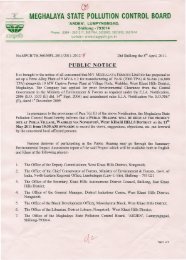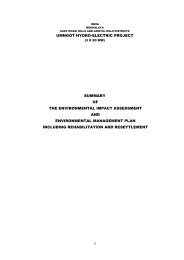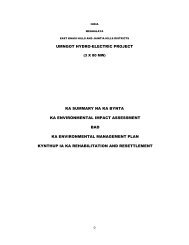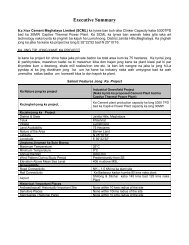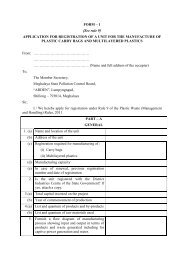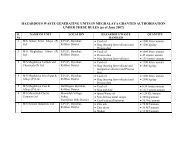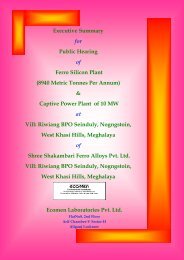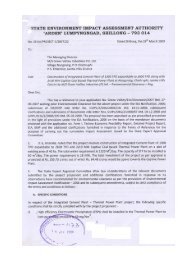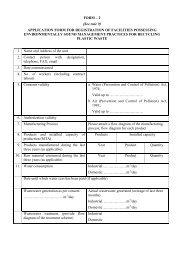chapter - 1 introduction - Meghalaya State Pollution Control Board
chapter - 1 introduction - Meghalaya State Pollution Control Board
chapter - 1 introduction - Meghalaya State Pollution Control Board
You also want an ePaper? Increase the reach of your titles
YUMPU automatically turns print PDFs into web optimized ePapers that Google loves.
Hills Cement Co. Limited.<br />
seals can last up to 10,000 to 20,000 hours, regular inspection may be<br />
needed to reduce leaks. Upgradation of the inlet pneumatic seals at a<br />
relatively modern plant in India has reduced fuel consumption in the kiln<br />
by 0.4%.<br />
Kiln Shell Heat Loss Reduction- There can be considerable heat losses<br />
through the shell of a cement kiln, especially in the burning zone. The use<br />
of better insulating refractories can reduce heat losses. Refractory choice<br />
is the function of insulating qualities of the brick and the ability to develop<br />
and maintain a coating. The coating helps to reduce heat losses and to<br />
protect the burning zone refractory bricks. Estimates suggest that the<br />
development of high temperature insulating linings for the kiln refractories<br />
can reduce fuel use by 0.1-0.34 MBtu/ton. costs. Structural considerations<br />
may limit the use of new insulation materials. The use of improved kilnrefractories<br />
may also lead to improved reliability of the kiln and reduced<br />
downtime, reducing production costs considerably, and reducing energy<br />
needs during start-ups.<br />
Refractories- Refractories protect the steel kiln shell against heat,<br />
chemical and mechanical stress. The choice of refractory material<br />
depends on the combination of raw materials, fuels and operating<br />
conditions. Extended lifetime of the refractories will lead to additional<br />
energy savings due to the relative reduction in start-up time and energy<br />
costs. The energy savings are difficult to quantify, as they will strongly<br />
depend on the current lining choice and management.<br />
Kiln Drives- A substantial amount of power is used to rotate the kiln. The<br />
highest efficiencies are achieved using a single pinion drive with an air<br />
clutch and a synchronous motor. The system would reduce power use for<br />
kiln drives by a few percent, or roughly 0.5 kWh/ton clinker at slightly<br />
higher capital costs (+6%).<br />
More recently, the use of AC motors is advocated to replace the<br />
traditionally used DC drive. The AC motor system may result in slightly<br />
higher efficiencies (0.5 – 1% reduction in electricity use of the kiln drive)<br />
and has lower investment costs. Using high-efficiency motors to replace<br />
older motors or instead of re-winding old motors may reduce power costs<br />
by 2 to 8%.<br />
<strong>Pollution</strong> <strong>Control</strong> Consultants (India) Pvt. Ltd. 120



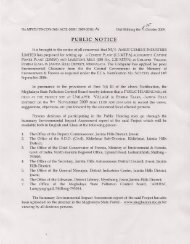


![[FORM I] - Meghalaya State Pollution Control Board](https://img.yumpu.com/49771786/1/190x245/form-i-meghalaya-state-pollution-control-board.jpg?quality=85)

